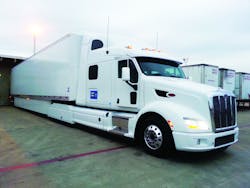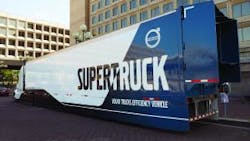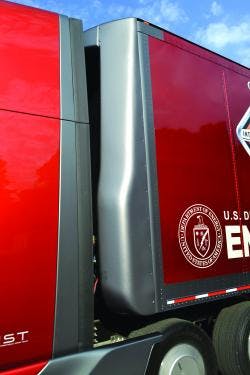Freightliner dubs it “the trailer that leads the way,” with tractor-trailer integration accounting for two-thirds of the freight efficiency gains of the Innovation Truck program. And the other truck makers that took part in the Dept. of Energy’s SuperTruck program came to similar conclusions: The next generation of fuel-efficient commercial vehicle designs indeed will be led from behind.
“If we were going to develop the truck of the future, we had to start with the trailer of the future,” says Pascal Amar, senior project manager for Volvo Group North America, discussing various Volvo SuperTruck technologies during the recent unveiling at DOE headquarters in Washington, DC.
And just last month, Navistar invited Fleet Owner for a spin in the newly revealed CatalIST, its SuperTruck that achieved 13 mpg.
“We’ve literally designed this vehicle from the back forward because there is a fundamental principle in aerodynamic design that says until you clean up the back of the truck and the trailer, you’re going to be limited with what you can do in the front,” says Dean Opperman, chief engineer, advanced vehicle technologies.
While the SuperTruck program is unrelated to the coming second round of truck fuel efficiency/greenhouse gas regulations (Phase 2 GHG) by the Environmental Protection Agency and the National Highway Traffic Safety Administration, many of the innovations born from the program will be incorporated into trailer designs to meet the new requirements. And though Phase 2 will essentially standardize trailer tails, side skirts, and low-rolling resistance tires on van trailers, there is leeway on the actual designs and combinations of those devices.
Among the special touches on the CatalIST trailer by Wabash National, for instance, are the skirt design, the “ball and socket” passive gap treatment, a bogie treatment on the tandem axles, and an extended boat tail design, Opperman points out.
“Fundamentally, the design of the trailer and tractor impact each other. We worked directly with Wabash [National] and were able to optimize our design around their specific technologies, and we will continue to do that with all different types of trailer aerodynamic technologies,” he says. “In a perfect world, we would like to be in control of both systems, but that’s never going to happen. But once we knew where we were going, it solidified a lot of things we wanted to do up front.”
Most significantly, the overall shape of the trailer is the key to developing more optimum, wing-like airflow by lowering the front and rear of the vehicle. As the CatalIST reaches highway speed and “changes shape,” the load bias also shifts forward toward the tag axle and the low-rolling resistance single tires.
Because of the improved aerodynamics and reduced rolling resistance, the CatalIST needs only about 80 hp. to cruise at 65 mph, Opperman notes.
Collaboration
Indeed, the goal-smashing collaboration has been a successful one, adds Gus Sumcad, director of engineering, Wabash Composites. “We’ve done something right, clearly,” he says. “The teaming and cooperation that we’ve done has been very effective.”
For SuperTruck, Wabash leveraged existing advanced designs and materials to improve fuel efficiency. The CatalIST trailer’s skirt is based on the new Wabash Ventix DRS (drag reduction system), in which segmented side panels manage airflow across the entire underbody.
“The basic architecture is available today, but we enhanced the design so that it integrated very well with the entire SuperTruck,” Sumcad says.
Of course, all of the hi-tech add-ons mean additional weight, so using the lightest composite materials in components was also important, he adds.
As for design, the SuperTruck project reinforced the concept that the tractor and trailer need to be treated as a single system to more effectively improve aerodynamics.
“In this particular case, narrowing the gap was very important,” Sumcad says, and he notes the value of testing various trailer fairing shapes using computational fluid dynamics to come up with an optimal shape.
Similarly, in order to give the tractor-trailer the airfoil shape without exceeding height limits, the project trailer utilized smaller wheels and tires as well as a hydraulic control mechanism—technology that is “fairly straightforward” and is likely to be implemented to meet Phase 2 goals in the future, Sumcad suggests.
Still, while the evolving aerodynamic shapes of tractors are converging, each brand has its own set of innovations and stylistic touches. So will trailer makers have to design the piece of the fuel efficiency puzzle for each model?
“Our intent across the board is to design a trailer so that we don’t have to customize it for every tractor,” Sumcad says. “You may have some trade-offs, but if you have opportunities that hit 85% of the requirements, you might push for that.”
Innovation roadmap
For trailer makers, the new Phase 2 requirements haven’t really changed the push for innovation, but the government has put a clock on them.
“We’re always looking at the quickest possible way to commercialize our innovations—and we’ll never stop doing that,” Sumcad says. “[The Phase 2 rule] just gives us more avenues to make sure we continue to be aggressive in bringing new technologies and reining in costs at the same time.
“It’s a challenge, but it’s all about planning and coordinating with our technology partners to make sure we have those technologies available in that timeframe. We feel very confident that, since we were able to demonstrate the weight savings as well as the aerodynamic improvements with SuperTruck, we’ll have a good set of solutions for our customers moving forward.”
And that’s the plan from EPA and NHTSA.
“The agencies are not requiring trailer manufacturers to install any particular device to their trailers,” they said in responding to trailer manufacturer concerns about the rule. “The standards for box vans are performance standards, and manufacturers can choose to install any combination of aerodynamic, tire, and weight-reduction technologies, or make changes to the trailer design to achieve the desired performance. Trailer manufacturers can evaluate and choose which devices to offer to their customers and install on their trailers.”
The agencies also recognized “the unique characteristics of the trailer industry” and developed Phase 2 with those characteristics in mind.
More to come
“The SuperTruck [program] is a great example of several things working together—optimizing components and systems, enhancing aerodynamic efficiencies, and maximizing operator performance,” Ken Damon, Peterbilt’s SuperTruck project manager, told Fleet Owner at a demonstration of the Peterbilt/Cummins project vehicle.
Near term, Damon emphasized that the focus will be on convincing fleets to alter their truck and trailer specs to gain a more fuel-efficient footprint. And like most truck OEMs, Peterbilt is continuing to develop “optimized spec packages” to deliver vehicles finely tuned for fuel efficiency to the best their application will allow.
A little farther down the road, he too believes the “design envelope” of the tractor-trailer will need to expand so it can adapt on the fly to changing conditions seen over the road.
“This means developing active aerodynamic devices that deploy at certain speeds and/or that react to changing wind conditions in order to keep the vehicle in the optimal aerodynamic configuration at all times,” Damon says.
While the truck and engine makers that took part in SuperTruck projects all pointed to some cost-prohibitive materials and technologies that could improve freight efficiency even more, DOE was impressed enough that it will fund a second round with another $80 million in research money, to be matched by grant recipients Daimler, Volvo, Navistar and Cummins.
And as Energy Secretary Earnest Moniz got a tour of the Volvo SuperTruck, having made his way around the truck and hearing about various technology highlights, he quipped half-jokingly, “So why do you need SuperTruck II?”
Amar’s enthusiastic response: “Because we finished this with so many more ideas!”
Birth of an innovation
The pitch to potential customers is so irresistible that a truck equipment buyer’s first reaction is likely one of skepticism: An add-on component from a brand new company that can be installed in an hour and will provide a 30% reduction in tractor-trailer fuel consumption with a 1-month ROI? Too good to be true?
The second reaction, based on the activity around the Hyliion display at the 2016 American Trucking Assns. Management Conference and Exhibition, is to look a little more closely at the innovative hybrid system, an intelligent electric drive axle for trailers that the company said will revolutionize trucking.
The Hyliion hybrid uses regenerative braking to capture power when the trailer slows, and returns the stored energy on inclines. And, as company founder and CEO Thomas Healy explained to Fleet Owner, the technology shouldn’t worry truckers who might be wary of something new. The components are already widely accepted in the marketplace; the trick is that no one has put them together in this way for trucking.
The sensor-driven intelligent system comes in at about 500 lbs., but that weight is offset somewhat because the battery pack also serves as an APU, capable of providing 20 hours of hotel power. The 30% fuel saving figure comes from a combination of the hybrid boost, APU-enabled idle reduction, and from the aerodynamic improvement the Hyliion unit’s enclosure provides to the trailer undercarriage.
The unit is fully autonomous and requires no driver input, but the data it collects and its built-in connectivity will offer customers trailer tracking capability and real-time performance analytics—and will allow the company’s software engineers to refine the controlling algorithms.
Healy fleshed out the idea in response to a professor’s challenge to come up with a product to save energy. The concept for the hybrid trailer system was good enough to earn an invitation to the prestigious Rice Business Plan Competition last year—except, at that point, it was only a concept.
“So, I got a team together and said, ‘okay, we’ve got two weeks to the competition—let’s try to build one of these,’” Healy says. “We went to a junkyard, grabbed an old Hendrickson suspension and an Eaton axle, then we flew out to California and picked up batteries, an electric motor, and control systems. It was hobbyist components, like you’d get to do a retrofit of a car.”
The design and rudimentary prototype took home a number of top prizes, including $50,000 from the Dept. of Energy’s Clean Tech Prize, $15,000 for the Clean Energy Innovation Prize from Wells Fargo, and $10,000 for Shell’s Technology Ventures Energy Prize. The concept also has received awards from venture fund SURGE for Most Innovative Energy Tech Startup.
The company is currently in the process of raising funds and plans to launch production with a short run in the coming first quarter.
About the Author
Kevin Jones 1
Editor
Kevin has served as editor-in-chief of Trailer/Body Builders magazine since 2017—just the third editor in the magazine’s 60 years. He is also editorial director for Endeavor Business Media’s Commercial Vehicle group, which includes FleetOwner, Bulk Transporter, Refrigerated Transporter, American Trucker, and Fleet Maintenance magazines and websites.



